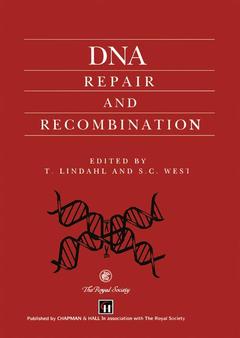Description
DNA Repair and Recombination, Softcover reprint of the original 1st ed. 1995
Authors: Lindahl T.R., West S.C.
Language: English
Subject for DNA Repair and Recombination:
Publication date: 10-2012
103 p. · 21x29.7 cm · Paperback
103 p. · 21x29.7 cm · Paperback
Description
/li>Contents
/li>
Genomic instability is a major threat to living organisms. To counteract the damaging effects posed by endogenous and environmental agents, such as chemicals or radiation, micro-organisms devote several percent of their genome to encode proteins that function in the repair and recombination of DNA. For many years, a relatively small group of scientists have carefully delineated the molecular mechanisms of these repair processes, using the simplest model systems available, namely Escherichia coli and Saccharomyces cerevisiae. These studies, which until recently had only moderate impact outside of the field, now provide the cornerstone for exciting new research into analogous processes in human cells. The reason for this is the revelation that the biochemical pathways for the accurate replication, repair and recombination of DNA have been conserved through evolution. New research shows that human cells use DNA repair mechanisms that are analogous to those found in bacteria to overcome the damaging effects of environmental mutagens and carcinogens. Of particular significance is the observation that certain cancers are caused by defects in DNA repair enzymes. For example, the human inherited non-polyposis colon cancer is now known to be caused by defects in the enzymes that repair DNA mismatches. Because much detailed information has been accumulated in studies of analogous mismatch repair proteins from bacteria, rapid progress can now be made.
1 RecA protein mediates homologous recognition via non-Watson—Crick bonds in base triplets.- 2 The initiation and control of homologous recombination in Escherichia coli.- 3 Formation, translocation and resolution of Holliday junctions during homologous genetic recombination.- 4 Structure of the four-way DNA junction and its interaction with proteins.- 5 Site-specific recombination and circular chromosome segregation.- 6 Steps along the pathway of V(D)J recombination.- 7 Regulation and mechanisms of gene amplification.- 8 Enzymes acting at strand interruptions in DNA.- 9 Nucleotide excision repair in the yeast Saccharomyces cerevisiae: its relationship to specialized mitotic recombination and RNA polymerase II basal transcription.- 10 Proteins that participate in nucleotide excision repair of DNA in mammalian cells.- 11 Nucleotide excision repair syndromes: molecular basis and clinical symptoms.- 12 On the regulation of the p53 tumour suppressor, and its role in the cellular response to DNA damage.- 13 Mismatch repair, genetic stability and tumour avoidance.- 14 Editing DNA replication and recombination by mismatch repair: from bacterial genetics to mechanisms of predisposition to cancer in humans.
© 2024 LAVOISIER S.A.S.




